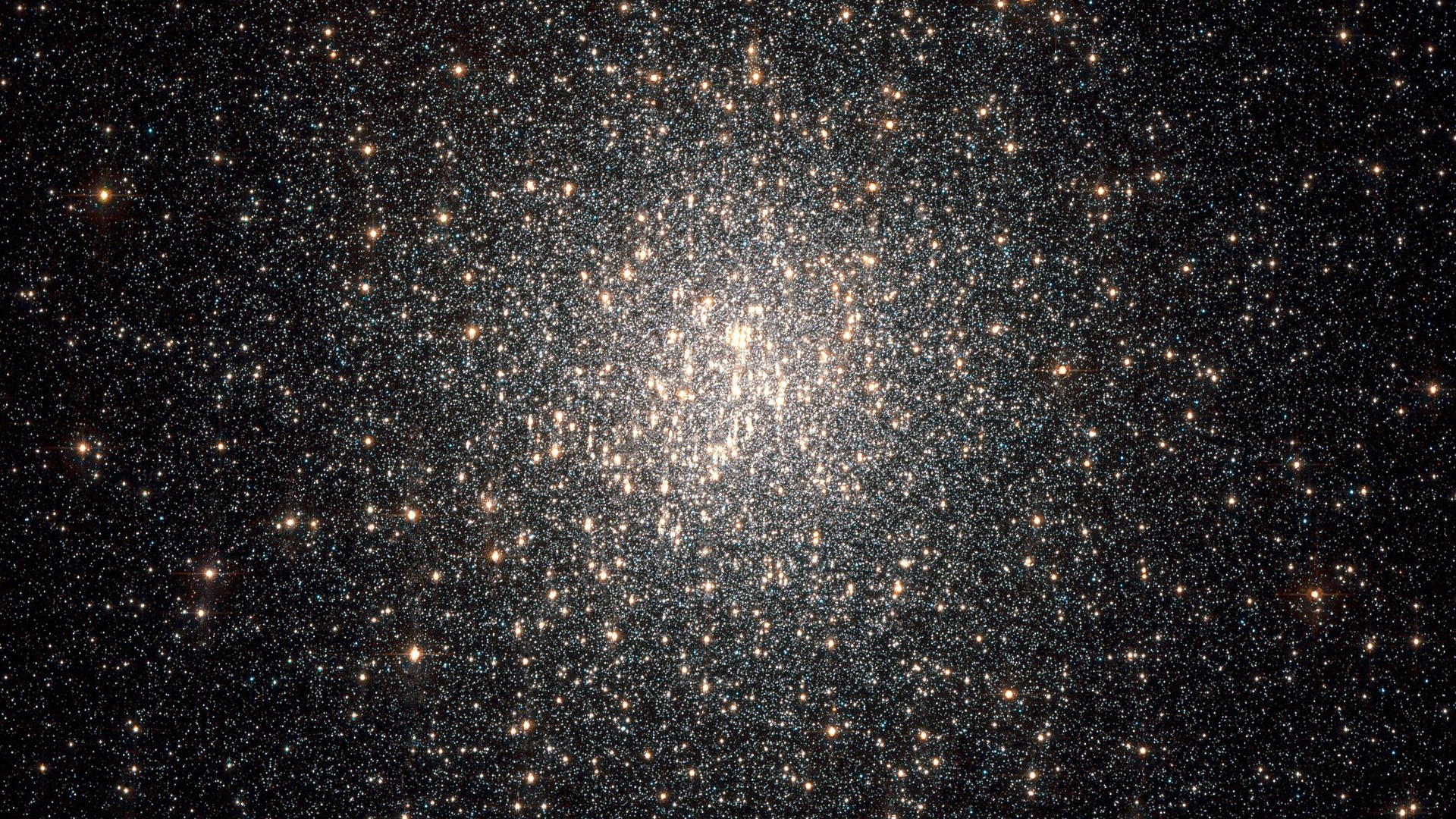Touring the Treats of Taurus Using Mobile Astronomy Apps
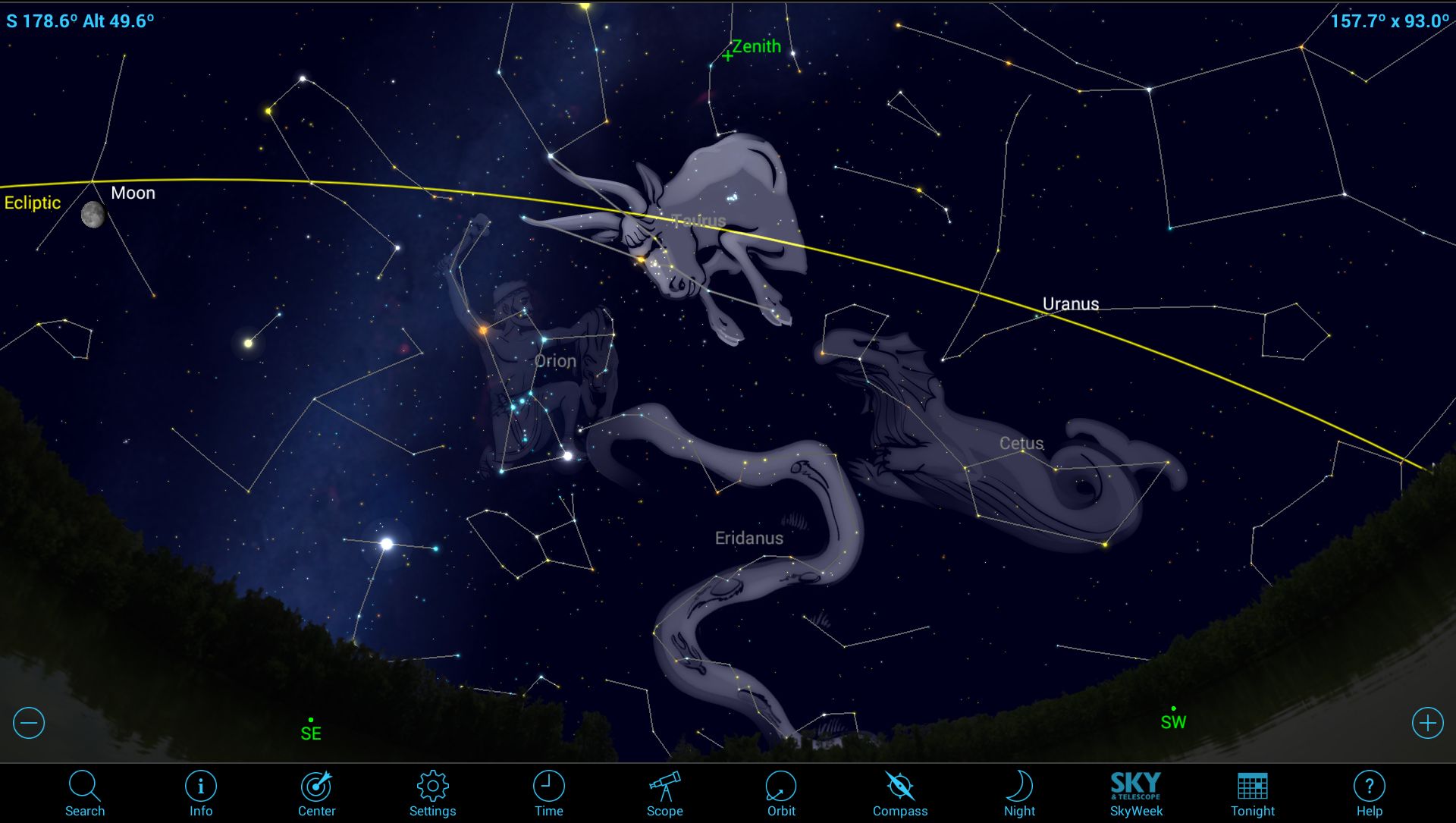
Every year in early December, the distinctive constellation of Taurus the bull returns to the evening skies, rising as darkness falls and crossing the sky through the night. It's one of a handful of distinctive winter constellations that are easy to recognize with just your eyes. Even better, like Orion, Auriga and Gemini, it contains many wonderful objects to observe using small or large telescopes — from spectacular star clusters to a supernova remnant and more.
In this edition of Mobile Astronomy, we'll take a tour of Taurus, pointing out some things you'll spy during a winter stroll and others that make setting up your telescope on a cold winter evening worth your while. Your mobile astronomy app can point the way to these interesting objects and tell you what makes them special.
Where to find Taurus
The constellation of Taurus is located on the ecliptic, just north of the celestial equator, making it visible almost globally. With the dim constellations of Cetus, Pisces and Aquarius lying just to the west of it (on the right), Taurus makes quite an entrance as the autumn nights lengthen. Taurus is the first in a parade of much brighter and better-known constellations: Orion, Gemini and Auriga. Being on Taurus' eastern side, they rise later in the evening. To the north sits Perseus and below Taurus is dim Eridanus. [Best Night Sky Events of December 2016 (Stargazing Maps)]
Several elements dominate Taurus, combining to make the bull. A large triangular arrangement of stars forms the bull's face, and the bright reddish star Aldebaran sits at one vertex, marking the animal's baleful eye. Two bright stars sitting 15 degrees to the east are the tips of the bull's horns, above the face; the little Pleiades cluster marks the hunched shoulders, and a handful of less prominent stars to the east form the chest and forelegs. The rest of the bull is missing. When the animal rises in the east, it is tilted sideways, horns down and legs extended, as if charging toward the twins of Gemini. The bull doesn't straighten up until after midnight when it enters the western half of the sky.
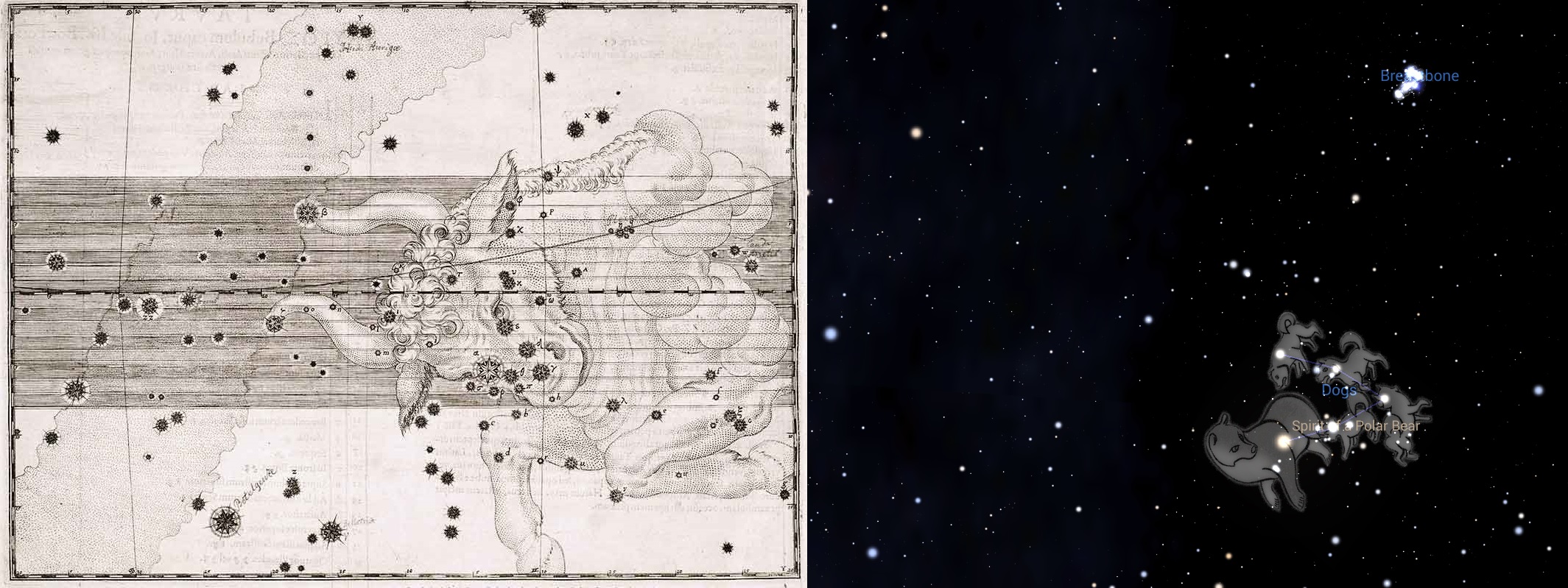
Skywatchers have recognized Taurus' distinctive shape since ancient times. It was one of the first constellations to be described. At that time, the spring equinox occurred with the sun in Taurus. (You can see this by setting your app's date to noon on April 9, 2250 BC.) The bull's strength and fertility were featured in ancient Babylonian and Sumerian myths and legends. In the Mesopotamian poem "Epic of Gilgamesh," the bull was sent to kill the character Gilgamesh (probably represented by Orion's stars).
In Greek mythology, Taurus represented Zeus in disguise, seeking to abduct lovely Europa, who was charmed by the animal's power and beauty. It may also have been the Cretan Bull, which Hercules slew during his 12 labours. In the Inuit traditions of the far north, Aldebaran represents a polar bear, and the rest of the stars in the triangle are dogs keeping the bear at bay. The Stellarium app for iOS and Android lets you see other cultures' representations of the constellations. Use the Starlore menu on the app and enable the constellation artwork to explore them.
Spotting Taurus visually
The constellation of Taurus is a wonderful area to observe, even with naked eyes. In mid-December, Taurus rises at 4 p.m. local time and climbs high into the southern sky around midnight, before descending westward to set at around 6 a.m. To find it, continue the line formed by Orion's belt westward (upward in early evening, or to the right later on) about two outstretched fist diameters (or 20 degrees) until you reach bright Aldebaran. If Orion hasn't risen yet, you can look high in the east for the little cluster of blue stars called the Pleiades. Taurus is about 12 degrees below that.
Get the Space.com Newsletter
Breaking space news, the latest updates on rocket launches, skywatching events and more!
Aldebaran means "follower" in Arabic. The star received that name because it chases the Pleiades across the sky. It's the brightest star in Taurus, an old orange giant located 65 light-years away from Earth. Somewhat cooler than the sun, it's more than twice as massive and 44 times the sun's diameter, because it has exhausted its core hydrogen and has swelled as it prepares to die. Aldebaran's position near the ecliptic means that it is frequently occulted (passed over) by the moon and visited by the planets as they traverse their orbits. Use your astronomy app to check out these occultations visible in the northeastern U.S.: June 22, 2017 (new crescent moon in daytime); Sept. 12, 2017 (first quarter moon in daytime); and Nov. 6, 2017 (waning gibbous moon in evening). The last one is the easiest, but you can use the moon to spot Aldebaran in daylight for the other two. Just center Aldebaran and adjust the time forward and backward to see the moon cross, or pass near, the star.
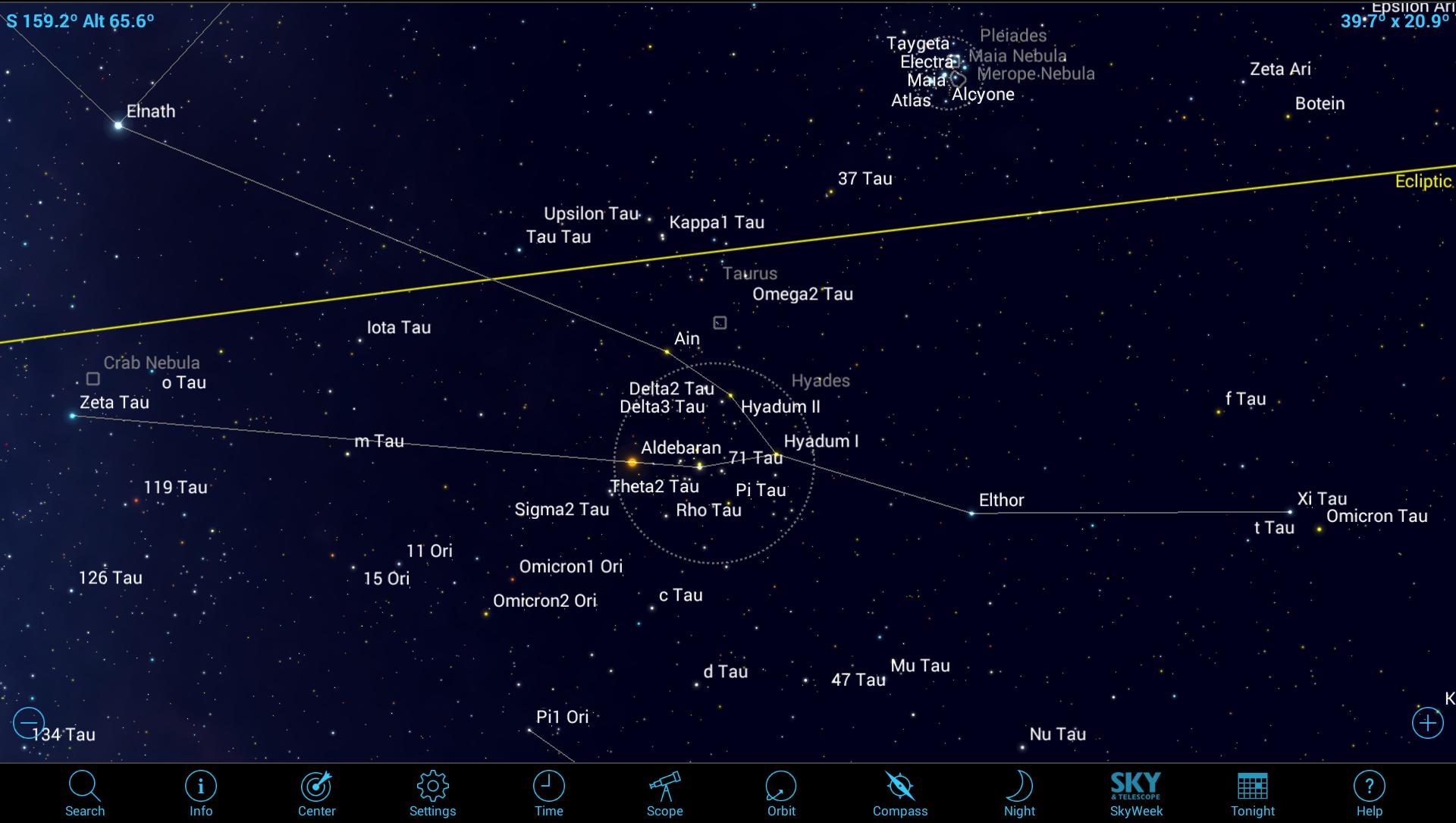
Taurus' triangular face is actually one of the nearest star clusters to Earth, at only about 150 light-years away. In your mobile app, it will be called the Hyades, named for the five daughters of Atlas in Greek mythology. It actually contains several hundred stars, with a half-dozen or so readily seen under moonless suburban skies. It's a lovely target to view in binoculars. The SkySafari app contains a lot of additional information about this interesting naked-eye, deep-sky object. By the way, Aldebaran is actually not part of the cluster. It is less than half as far away!
The star Elnath, or Alnath, which translates to "the butting one," is an old, bright, hot, blue-giant star located 130 light-years away from Earth that marks the bull's more northerly horn tip. On the border of Taurus and Auriga, it's one of only two stars in the sky that are shared by two constellations. (The other is Alpheratz in Andromeda/Pegasus.)
The other horn-tip star is less bright, but is still readily seen by eye. It was once referred to as Shurnarkabti-sha-shūtū, "the star in the bull toward the south," but nowadays it's simply called Zeta Tauri (or ζ Tau). This star is a hot, blue subgiant. It's located 420 light-years away, but radiating 6,700 times the light of Earth's sun. Zeta is a candidate to explode one day in a supernova burst, which is ironic since it sits very close to a supernova remnant, the Crab Nebula (more on this below).
The Pleiades
One of my favorite objects in Taurus sits about one and a half fist widths above the bull's face: the beautiful star cluster known as the Pleiades, or the Seven Sisters. Your astronomy app will also refer to it as Messier 45 (or M45), part of Charles Messier's famous list of comet-like objects. It consists of young, hot, blue stars — Asterope, Merope, Electra, Maia, Taygeta, Celaeno and Alcyone — that are indeed related, as they were all born of the same primordial gas cloud. In Greek mythology, their namesakes were the daughters of Atlas and half sisters of the Hyades. To the naked eye, only six of the sister stars are usually seen, with their parents, Atlas and Pleione, huddled together at the east end of the grouping. Under magnification, hundreds of stars appear.
The cluster is about 450 light-years away and makes a wonderful target in binoculars or a telescope, where many more siblings are revealed! A large telescope under dark skies will also reveal blue nebulosity around the stars. This is reflected light from unrelated gas that the stars are passing through. Galileo was among the first to observe the object in a telescope. In 1610, he published a sketch made at the eyepiece.
Not surprisingly, many cultures, including Aztec, Maori, Sioux and Hindu, have noted this object and developed stories around it. In Japan, it is called Subaru and forms the logo of the eponymous carmaker. Due to its shape, some people mistake the Pleiades for the Little Dipper. [Best Telescopes for the Money - 2016 Reviews and Guide]
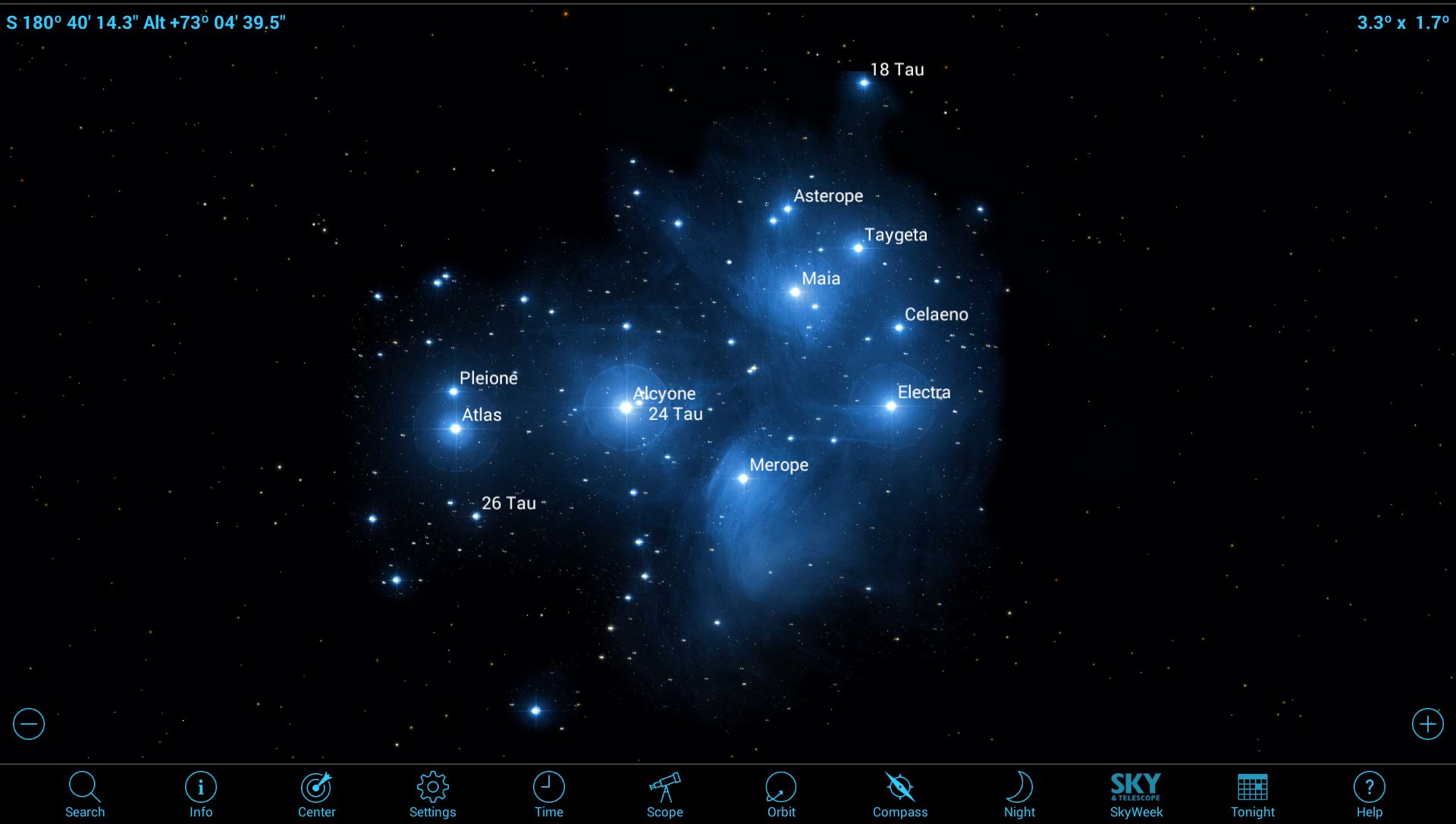
Binocular and telescope targets
The Hyades contains a number of nice double stars. Two degrees to the right of Aldebaran (toward the bull's chin), look with naked eyes or binoculars for the pair of stars designated Theta 1 and 2. The higher one is slightly yellower. Also easy to find, on the opposite cheek are three widely spaced stars all designated Delta Tauri. Your app may label them as Hyadum II, Delta 2, and Cleeia or Delta 3. Slightly below Aldebaran, hunt with binoculars for the close pair of white stars named Sigma 1 and 2.
Here are a few more interesting objects to hunt for. Use your app to find 47 Tauri about 9 degrees to the lower right of Aldebaran. It's a close pair of unevenly bright yellow stars. Farther west, look for T Tauri, a very young star recently formed and still surrounded by some of its protostellar disk. Lambda Tauri is a fairly bright star located 5 degrees to the right of the bull's chin. Lambda Tauri is an eclipsing binary variable star; it dims in brightness for 1.1 days every 4 days. The changes are caused by the system's two stars, a bright star which is regularly obscured from Earth's perspective by an orbiting companion star as it crosses in front. Your app might also designate it as Elthor "the bull."
Perhaps the most notable object in Taurus is the Crab Nebula, also known as Messier 1 (or M1). This fuzzy, gray cloud, visible via a medium-to-large telescope, is the fading explosion of a supernova. The star, 6,500 light-years distant, violently ended its life in a spectacular burst of intense light that was visible during the daytime for three weeks and shone brightly at night for two years.
Classical Chinese astronomers first sighted the event on July 4, 1054. Nowadays, astronomers observe the still expanding and fading debris in visible light, and the signal of a rapidly spinning neutron star (or pulsar) in radio frequencies. The Crab Nebula is located about 1 degree above (northwest of) Zeta Tauri, the lower horn tip. In a backyard telescope under moonless nights, look for an elongated dim patch about 6-by-4 arc-minutes (the moon is 30 arc-minutes across).
There are even more sights to see in Taurus, and the outer rim of the Milky Way passes just beyond the horn tips, so this area will reward scanning with binoculars or telescope, too.
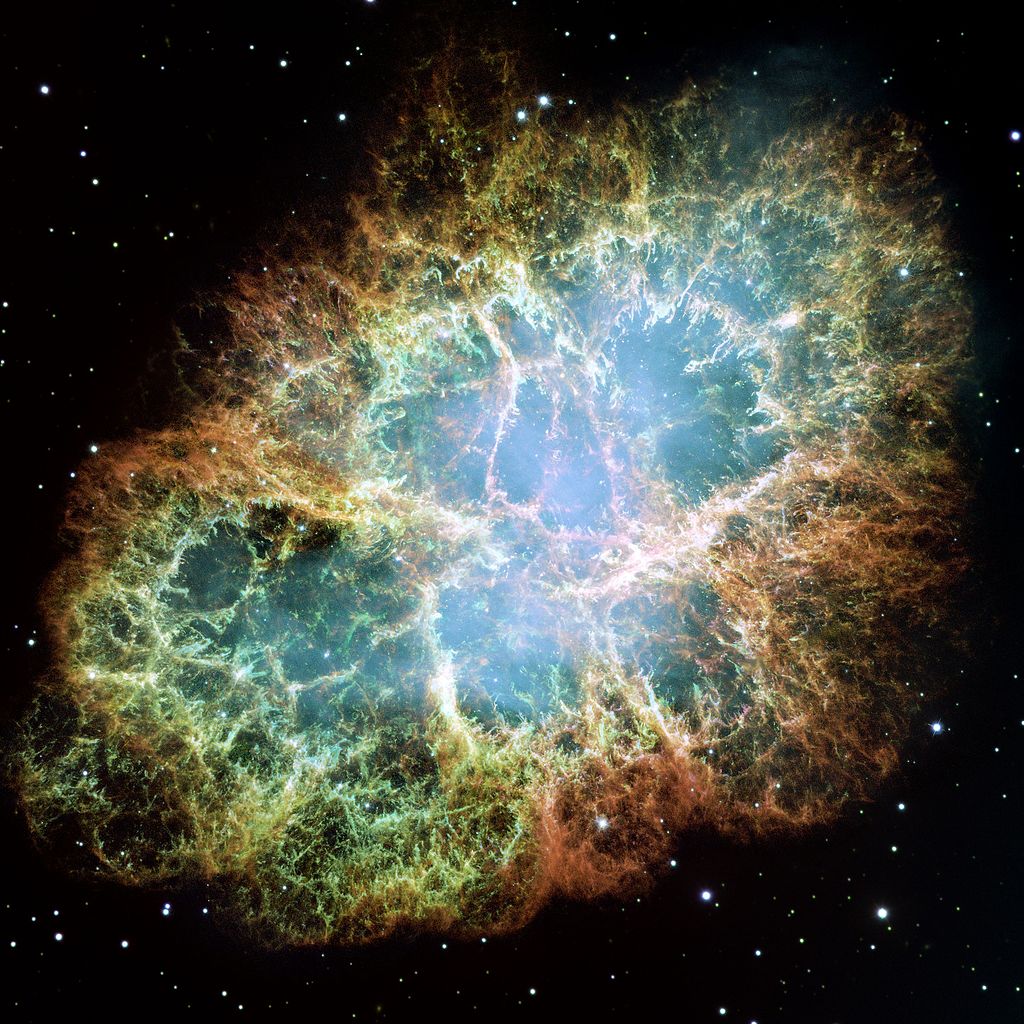
Going beyond
There is a remarkable hypothesis that the stars of Taurus and nearby Orion's belt were incorporated into the ancient paintings found on the caves of Lascaux in southern France. The paintings were created somewhere between 8,000 and 17,000 years ago. On the ceiling of the "Salle des Taureaux," or Room of the Bulls, are very large color paintings of horned bulls, one of which has dark facial spots approximating the Hyades, a grouping of six stars where the Pleiades should be, and a line of stars resembling Orion's belt. Even the horns are placed where the stars are found. It's wonderful to imagine early humans capturing the night sky for posterity!
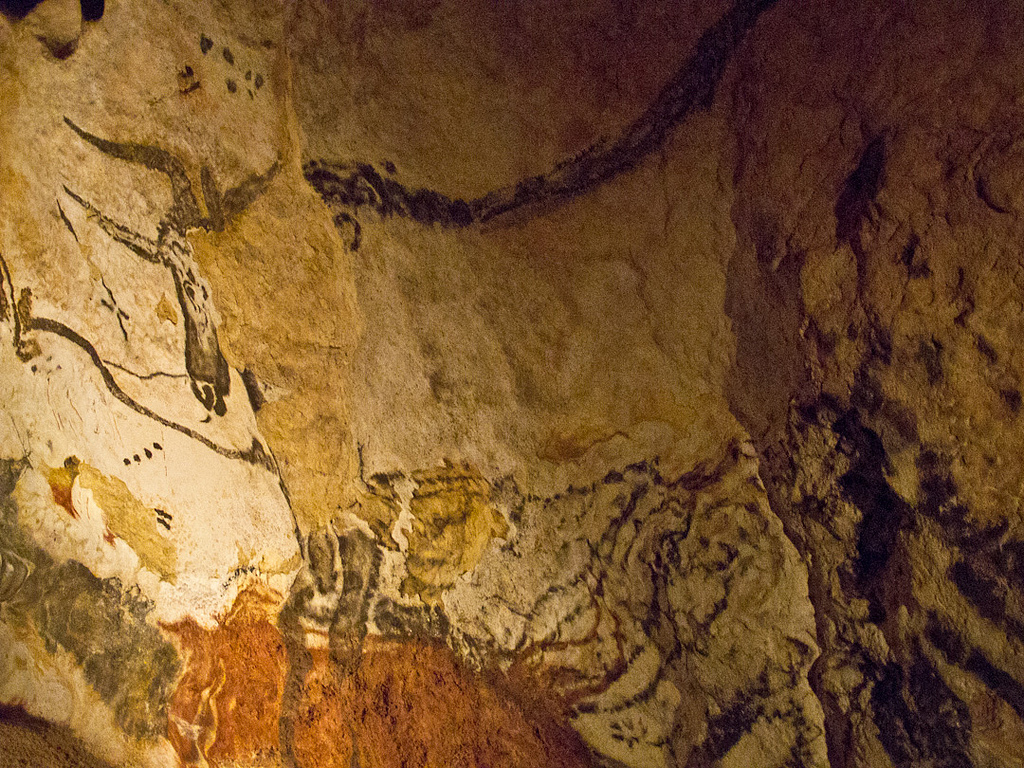
In upcoming editions of Mobile Stargazing, we'll look ahead to the astronomical events for 2017 and check out what's new in apps and gadgets. Until then, keep looking up!
Editor's note: Chris Vaughan is an astronomy public outreach and education specialist, and operator of the historic 1.88-meter David Dunlap Observatory telescope. You can reach him via email, and follow him on Twitter as @astrogeoguy, as well as on Facebook and Tumblr.
This article was provided by Simulation Curriculum, the leader in space science curriculum solutions and the makers of the SkySafari app for Android and iOS. Follow SkySafari on Twitter @SkySafariAstro. Follow us @Spacedotcom, Facebook and Google+. Original article on Space.com.
Join our Space Forums to keep talking space on the latest missions, night sky and more! And if you have a news tip, correction or comment, let us know at: community@space.com.
Chris Vaughan, aka @astrogeoguy, is an award-winning astronomer and Earth scientist with Astrogeo.ca, based near Toronto, Canada. He is a member of the Royal Astronomical Society of Canada and hosts their Insider's Guide to the Galaxy webcasts on YouTube. An avid visual astronomer, Chris operates the historic 74˝ telescope at the David Dunlap Observatory. He frequently organizes local star parties and solar astronomy sessions, and regularly delivers presentations about astronomy and Earth and planetary science, to students and the public in his Digital Starlab portable planetarium. His weekly Astronomy Skylights blog at www.AstroGeo.ca is enjoyed by readers worldwide. He is a regular contributor to SkyNews magazine, writes the monthly Night Sky Calendar for Space.com in cooperation with Simulation Curriculum, the creators of Starry Night and SkySafari, and content for several popular astronomy apps. His book "110 Things to See with a Telescope", was released in 2021.


